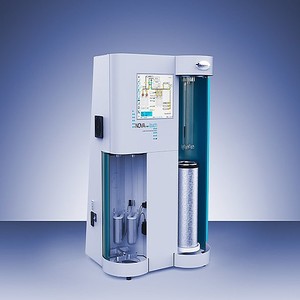Bet Surface Area Analyzer (BET)

Instrument Details
Make :Quantachrome Instruments Nova Touch lx4 Model
Principle
By BET (Brunauer, Emmett and Teller) the specific surface area of a sample is measured – including the pore size distribution. This information is used to predict the dissolution rate, as this rate is proportional to the specific surface area. Thus, the surface area can be used to predict bioavailability. Further it is useful in evaluation of product performance and manufacturing consistency.The specific surface area of a powder is determined by physical adsorption of a gas on the surface of the solid and by calculating the amount of adsorbate gas corresponding to a monomolecular layer on the surface. Physical adsorption results from relatively weak forces (van der Waals forces) between the adsorbate gas molecules and the adsorbent surface area of the test powder. The determination is usually carried out at the temperature of liquid nitrogen. The amount of gas adsorbed can be measured by a volumetric or continuous flow procedure.
BET is used to analyse Surface Area Analysis and Pore Size Measurement by Gas Sorption.The BET instrument applied by Particle Analytical (Micromeritics Gemini 2375 and Gemini V) determines the specific surface area (m²/g) of pharmaceutical samples. The samples are dried with nitrogen purging or in a vacuum applying elevated temperatures. Unless otherwise instructed we use P/P0 of 0,1, 0,2 and 0,3 as standard measurement points. The volume of gas adsorbed to the surface of the particles is measured at the boiling point of nitrogen (-196°C). The amount of adsorbed gas is correlated to the total surface area of the particles including pores in the surface. The calculation is based on the BET theory.Traditionally nitrogen is used as adsorbate gas. Gas adsorption also enables the determination of size and volume distribution of micropores (0.35 – 2.0 nm).
Application
Carbon for rubber, adsorbents (water purification and gas separation), inks, gas masks, laser printers, and copiers.Carbon for rubber, adsorbents (water purification and gas separation), inks, gas masks, laser printers, and copiers.Catalysts for the fertilizer, automotive, fertilizer, petrochemical, and fuel cell industries.Minerals such as clays, alumina, hydroxyapatite, phosphates, pigments, silica, zirconia, etc used for abrasives, adsorbents, biomaterials, ceramics, cement, desiccants, fillers, papers and paints.Organic materials for chromatography, adhesives, cosmetics, detergents, foodstuffs, explosives, ion exchange resins, pharmaceuticals, and plastics.Powdered metals and ferrites for batteries, pressure formed/ sintered products, electronics, magnetic tape, and magnets.Other applications related to bone, composite materials, fibers, rigid foams, soil, sludge, slurries, suspensions, well cores, and many more.
Fee details and submission of application
For fee details, please visit https://kusicc.ac.in/analysis-rates/. The request form for the instrument shall be downloaded from https://kusicc.ac.in/downloads/. Read the instructions given in the form and at the bottom of the analysis rates page carefully before submitting the application. Proper method and area of focus for result has to be mentioned for accuracy.
Location: Central Laboratory for instrumentation and facilitation, University of Kerala, Karivattom campus Trivandrum
You can also log on to the I-STEM Portal ( www.istem.gov.in) and book slots for the equipment.
